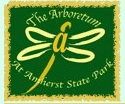favicongohere

Please use the navigation menu at bottom the Page
MenuGoHere

The Birds of Amherst State Park
Over the past twenty years I have seen less than a dozen long-eared owls in Western New York and until this year all of those were winter visitors. Thus it came as a pleasant surprise when in April one was reported in Amherst State Park. (The as yet undeveloped park is the former Sisters of St. Francis property along Ellicott Creek just north of the Village of Williamsville. It may be entered from Mill Street.)
Richard Salembier found this owl in the thick pine grove below the former Sisters' residence. How he did so is beyond me because it took him several minutes to help me see where it stared down at us from its perch high in the trees. I would never have been able to find it myself and, in fact, my subsequent searches without Salembier as guide were unsuccessful.
To me the long-eared owl is one of the most attractive of birds. It is not showy like the cardinal or oriole; rather, its coloration is soft but I believe equally beautiful. Mostly its feathers are various shades of soft brown but its facial disks are a rich chestnut quite similar to those of the great horned owl. Between those disks is a distinctive narrow white V that reaches and borders the dark bill.
Years ago in Montana I joined Denver Holt of the Missoula-based Owl Research Institute on an owl banding excursion. They set up a mist net in a lane through a woodlot and, much to my surprise, quickly captured a long-eared owl that they had flushed. As they banded the bird I was able to see it up close. What most surprised me was how small this bird was when in the hand. It came as a shock to learn that the long-eared owl is smaller than a crow. Apparently it is those fluffed-up feathers that make it appear larger than life.
One reason I had so much trouble sighting the Amherst owl was its ability to adopt what John Dunn calls its "camouflage posture." It had flattened its feathers to make it appear just like a vertical branch. When I finally found the bird in my binocular field, it seemed to recognize that it had been discovered. It appeared to take a deep breath, expanding its feathers to give its body a more normal shape.
Soon that owl attracted a mate and the pair nested in the same pine grove. My last observation was of one of the pair sitting on their nest perhaps 25 feet up in one of those pines. The flimsy stick platform they had chosen was probably built by a crow the previous year because long-ears seldom construct their own nest.
Salembier followed the progress of the pair and in May saw two already feathered owlets on the nest. Hopefully these birds fledged and have joined their parents patrolling the area for rodents. I say hopefully because Dave Junkin tells me that the young birds often leap out of the nest before they are able to fly and drop to the forest floor. Although they soon climb up into lower branches, until they could fly they would be easy prey for a cat, fox, coyote or dog.
The long-eared owl is one of our most beneficial of raptors. According to Arthur Cleveland Bent, "a large proportion of its food, probably 80 to 90 percent on a seasonal average, consists of injurious rodents." He found no case of the owls attacking poultry and only one of an owl killing a game bird. One analysis of owl pellets and stomachs of dead owls more than supports Bent. It found among the 3,273 vertebrates identified almost 99 percent rats and mice, less than one percent small birds.
I have purposely delayed writing this column until after this owl family has had a chance to complete its breeding cycle so that they would not be disturbed. Salembier too was careful not to call attention to the owls as people, many of them accompanied by dogs, followed trails through the woodlot often unknowingly passing directly below the nest.-- Gerry Rising
Long-eared Owl
(This 745th Buffalo Sunday News column was first published on July 10, 2005.)

Long-eared Owl painting by Major Allan Brooks









